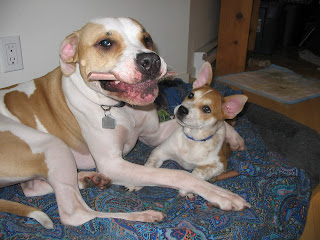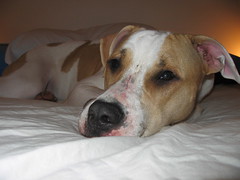

- that the term “pit bull” is constitutionally vague (it is a term used to describe a multitude of dog breeds), and
- vets cannot determine the breed of a dog since it violates the standard of fairness because it doesn’t allow for a fair hearing
A brief summary of the legislation:
- Pit bull type dogs born after November 26, 2005 are ordered to be destroyed or transferred to a research lab.
- Peace officers are entitled to enter your home without a warrant and remove your dog (of any breed) simply based on a belief that you contravened the legislation. Search and seizure without a warrant = a huge violation of individual rights.
- All pit bull type dogs, or any dog that resembles a pit bull, are required to wear muzzles and be on a short leash at all times (last summer Ontarian Tom Tilley was saved from a bear by his unleashed, unmuzzled pit bull Sam who leapt between Tom and the bear--maybe Tom should be charged with violating the law?).
- Reverse onus: dog owners are required to prove that their dog is not a pit bull type dog. There is no way to prove the breed of a dog other than if it has pedigreed papers.
- No ability to cross-examine the alleged expert who is speaking about breed identification. The ability to cross-examine witnesses is a fundamental tenet of our justice system.
- Pit bulls are not allowed to enter, or even pass through the province (one of the Superdogs named “Tadpole”, an English Staffordshire Terrier, was not allowed to perform in the Ontario show).
- If your “pit bull” gets picked up by Animal Control there is no way to get the dog back.
- Animal control officers can now use “necessary force” on dog owners who resist handing over their beloved dogs.
- Animal control can either destroy impounded pit bulls, or transfer them to animal research facilities for vivisection.
- Any violation of any of the restrictions can result in immediate apprehension and destruction of your dog and jail time for the owner.
Michael Bryant, the AG and force behind the pit bull ban, was proud that “only 2 out of 117 provisions were affected” by the recent court decision. Unfortunately for the AG, who apparently forgot most of his legal training, his joy is hollow. The legislation uses the term “pit bull” throughout, and since that term is now deemed too vague to be enforceable, his prized legislation is currently without teeth (pardon the pun). In fact, the legal mess that is his legislation is confusing to legal professionals and the public alike.
Although I’m not risking my dog’s safety in order to test the legal limbo in Ontario right now, anyone who owns a “pit bull type” dog which is not an American Staffordshire Terrier or a Staffordshire Bull Terrier could theoretically ignore the legislation. In the next few weeks, the court will address how the decision will be enforced. The judge could either rewrite the legislation (Michael Bryant’s preference but would be appealed) or send it back to the legislature (results of this action are questionable in the current political climate in Ontario).
Winnipeg banned “pit bulls” in 1990. In a 2002 study, researchers found that bites by many other breeds had increased drastically since the ban was implemented. In 1989 there was one reported bite by a Rottweiller/Rottweiller cross and in 2001 there were 37 reported bites by Rottweillers/Rottweiller crosses. And yet Michael Bryant trumpets the supposed success of the Winnipeg ban. He has a great ability to speak confidently in the face of absolute evidence to the contrary.
The breed of the dog is not a constant variable in reported dog attacks. Common factors related to dog attacks include:
- neglected and/or unsocialized dogs (haven’t been exposed to other dogs and people and taught how to politely interact with them)
- unneutered dogs (neutering changes a dog’s behaviour and reduces aggression)
- dogs traveling in packs (2 or more)
- unleashed dogs (dogs need to be under their owner’s control at all time in public)
- dogs on chains (goes along with lack of socialization and brings out a guarding-related aggression)
- and, of course, owners who go out of their way to make their dogs aggressive.
Anyone with either a science background or who has read the extremely popular book “Freakanomics” can dissect the arguments against pit bulls quite easily. In studies that highlight the number of dog attacks by breeds (some of which show that “pit bulls” and “pit bull” crosses are overrepresented) the figures are often used as evidence of a greater propensity for violence in “pit bulls”. However there are other variables at work. For example, pit bulls currently hold the “bad dog” label (previously held by Dobermans, German Shepherds, and Rottweillers) and are frequently owned by young, irresponsible owners who want a dog with a “tough” reputation. If Husky dogs became the new sensationalized "tough dog" we would see more reports of attacks by neglected, abused, unsocialized Huskies.
However, young male gang members are not the only ones who choose to own pit bulls. Many people and families choose to own pit bull type dogs for entirely different reasons. Pit bull breeds are excellent and patient with children, incredibly loyal and friendly, and score higher than most other breeds on canine temperment tests. In fact, they score higher than Golden Retrievers, the current “family sweetheart”.
So why do we hear about so many pit bull attacks in the news in comparison to other dog attacks? Well grasshopper, the same reason that you hear more about individuals who die in murders, home invasions, bar shootings and robberies than individuals who die of old age or from smoking cigarettes on the news. The media loves to feed moral panics, and increases their audience by covering the sensational stories. “Cocker Spaniel Bites Child” has a little less impact than “Two Pit Bulls Maim Elderly Woman”.
Common myths about “pit bulls” include:
- the “locking jaw”
o Ah yes. If this were true pit bulls would be a different species. And what would happen if a “locking jaw” pit bull were to breed with a regular lab? This myth wins the award for ridiculousness. - pit bulls can “snap” at any moment
o Pit bull breeds are the same as any other breed of dog. If a dog suddenly turns violent it is either the result of a brain defect (quite rare) or because the guardian of the dog was not adequately supervising the situation their dog is in. - it’s “in their blood” to be aggressive towards humans
o Pit bull type dogs have a tendency toward dog aggression just as some dogs have a greater prey drive, or some dogs have guarding instincts. That’s why it’s important that owners of pit bulls are educated and responsible. Dog aggression is entirely different than human aggression, which has to be taught to a dog. Many pit bulls “fail” at attempts to train them to be human aggressive because their love for humans is deeply entrenched.
I find it so frustrating that ridiculous legislation can only be overturned if it violates an individual’s Charter rights. Why shouldn’t laws be based on sound scientific research and fact, rather than political fervor and moral panics?
For more information about pit bulls and pit bull rescue, visit www.hugabull.com, www.goodpooch.com, www.badrap.org (among many others).

